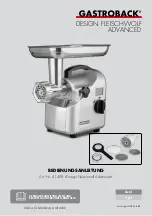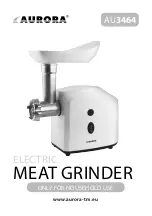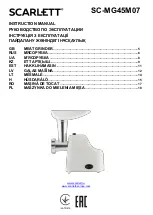
12
ENGLISH
(Original instructions)
Hints for optimum use
u
Firmly hold the tool with one hand around the side handle
and the other hand around the main handle.
Surface grinding with grinding wheels
u
Allow the tool to reach full speed before touching the tool
to the work surface.
u
Apply minimum pressure to the work surface, allowing the
tool to operate at high speed. Grinding rate is greatest
when the tool operates at high speed.
u
Maintain a 20˚ to 30˚ angle between the tool and work
surface.
u
Continuously move the tool in a forward and back motion
to avoid creating gouges in the work surface.
u
Remove the tool from work surface before turning tool off.
Allow the tool to stop rotating before laying it down.
Edge grinding with grinding wheels
Wheels used for cutting and edge grinding may break or
kick back if they bend or twist while the tool is being used
to do cut-off work or deep grinding. To reduce the risk of
serious injury, limit the use of these wheels with a standard
Type 27 guard to shallow cutting and notching (less than 1/2
inch (13mm) in depth). The open side of the guard must be
positioned away from the operator. For deeper cutting with a
Type 1 cut-off wheel, use a closed Type 1 guard.
u
Allow the tool to reach full speed before touching the tool
to the work surface.
u
Apply minimum pressure to the work surface, allowing the
tool to operate at high speed. Grinding rate is greatest
when the tool operates at high speed.
u
Position yourself so that the open-underside of the wheel
is facing away from you.
u
Once a cut is begun and a notch is established in the
workpiece, do not change the angle of the cut.
Changing the angle will cause the wheel to bend and may
cause wheel breakage. Edge grinding wheels are not
designed to withstand side pressures caused by bending.
Remove the tool from the work surface before turning the tool
off. Allow the tool to stop rotating before laying it down.
Do not use edge grinding/cutting wheels for surface grinding
applications because these wheels are not designed for side
pressures encountered with surface grinding. Wheel breakage
and injury may result.
Using wire cup brushes and wire wheels
Wire wheels and brushes can be used for removing rust, scale
and paint, and for smoothing irregular surfaces.
Note:
The same precautions should be taken when wire
brushng paint.
u
Allow the tool to reach full speed before touching the tool
to the work surface.
u
Apply minimum pressure to work surface, allowing the tool
to operate at high speed. Material removal rate is greatest
when the tool operates at high speed.
u
Maintain a 5˚ to 10˚ angle between the tool and work
surface for wire cup brushes.
u
Maintain contact between the edge of the wheel and the
work surface with wire wheels.
u
Continuously move the tool in a forward and back motion
to avoid creating gouges in the work surface. Allowing the
tool to rest on the work surface without moving, or moving
the tool in a circular motion causes burning and swirling
marks on the work surface.
u
Remove the tool from the work surface before turning
the tool off. Allow the tool to stop rotating before setting it
down.
Use extra care when working over an edge, as a sudden
sharp movement of grinder may be experienced.
Precautions to take when wire brushing paint
u
Wire brushing of lead based paint is NOT RECOMMEND-
ED due to the difficulty of controlling the contaminated
dust. The greatest danger of lead poisoning is to children
and pregnant women.
u
Since it is difficult to identify whether or not a paint con
-
tains lead without a chemical analysis, we recommend the
following precautions when wire brushing any paint:
Personal safety
u
No children or pregnant women should enter the work
area where the paint brushing is being done until all clean
up is completed.
u
A dust mask or respirator should be worn by all persons
entering the work area. The filter should be replaced daily
or whenever the wearer has difficulty breathing.
Note:
Only those dust masks suitable for working with lead
paint dust and fumes should be used. Ordinary painting masks
do not offer this protection. See your local hardware dealer for
the proper respiratory protection.
u
NO EATING, DRINKING or SMOKING should be done
in the work area to prevent ingesting contaminated paint
particles. Workers should wash and clean up BEFORE
eating, drinking or smoking. Articles of food, drink, or
smoking should not be left in the work area where dust
would settle on them.
Environmental safety
u
Paint should be removed in such a manner as to minimize
the amount of dust generated.
u
Areas where paint removal is occurring should be sealed
with plastic sheeting of 4 mils thickness.
u
Wire brushing should be done in a manner to reduce
tracking of paint dust outside the work area.
Summary of Contents for Fatmax SFMCG700
Page 1: ...www stanley eu 1 1a 2 3 4 5 7 6 SFMCG700...
Page 3: ...3 6 8 8b 8a A 6 6a B 6 C 6 6b 9 10 D E 5 14 13 15 12 14 11 F...
Page 139: ...139 STANLEY FATMAX SFMCG700 1 2 RCD RCD 3 4...
Page 140: ...140 5 130 C 6 u u u u u u...
Page 141: ...141 u u u u u u u u u u 11 u u u u u u...
Page 142: ...142 u u u u u u u u u u u u u u 8 u u u u u...
Page 146: ...146 J 3 2 1 4 u 1a 2 u 2 1a u u u u 20 30 u u 27 13 mm 1 2 1 1 u u u u u u u 5 10 u u...
Page 147: ...147 u u u u u u u u 4 mil u u u u u u u u STANLEY FATMAX u u u u u u u STANLEY FATMAX...
Page 150: ...150 27 27 27 27 27 1 1 1 27...
Page 151: ...151...













































